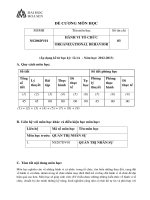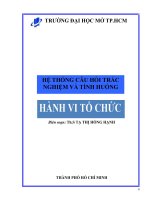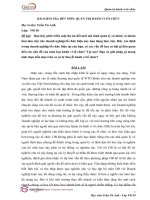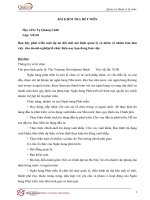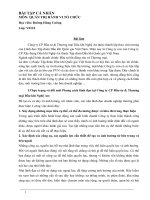Đề cương trắc nghiệm Hành Vi Tổ Chức (Organizational Behavior) CHƯƠNG 14
Bạn đang xem bản rút gọn của tài liệu. Xem và tải ngay bản đầy đủ của tài liệu tại đây (46.25 KB, 13 trang )
Chapter 14: Organizational Leadership
14-1. The abilities, values, personality traits, and other characteristics of
people that lead to superior performance represent which of these
leadership perspectives?
a. Romance
b. Contingency
c. Behavioral
d. Transformational
e. Competency
The question was not answered. The correct answer is "e".
14-2. All of these are part of the seven competencies of effective leaders
except
a. drive.
b. intelligence.
c. self-confidence.
d. authority.
e. emotional intelligence.
The question was not answered. The correct answer is "d".
14-3. A personality trait referring to the extent that people are sensitive
to situational cues and can readily adapt their own behavior
appropriately is called
a. self-monitoring personality.
b. integrity.
c. leadership motivation.
d. drive.
e. None of these because it is a behavior, not a trait.
The question was not answered. The correct answer is "a".
14-4. The best leadership style, according to the Leadership Grid,
represents which of these?
a. 9,1
b. 1,9
c. 9,9
d. 5,5
e. 1,1
The question was not answered. The correct answer is "c".
14-5. A 1,9 leadership style, according to the Leadership Grid, would
focus on
a. maximizing productivity through power and authority.
b. developing good feelings among employees even when production
suffers.
c. maintaining the status quo by adopting a middle-of-the-road approach.
d. doing the minimum to maintain organizational membership.
e. None of these.
The question was not answered. The correct answer is "b".
14-6. Team management, according to the Leadership Grid, represents
which of these?
a. High concern for people and low concern for production
b. Low concern for people and high concern for production
c. High concern for people and high concern for production
d. Low concern for people and low concern for production
e. Moderate concern for people and production.
The question was not answered. The correct answer is "c".
14-7. Path-goal theory has its roots in which theory of motivation?
a. Two-factor
b. Expectancy
c. Goal setting
d. Equity
e. Learned needs
The question was not answered. The correct answer is "b".
14-8. Which of these is not a leadership style identified by the path-goal
theory?
a. Participative
b. Achievement-oriented
c. Directive
d. Supportive
e. Competitive
The question was not answered. The correct answer is "e".
14-9. According to the path-goal model, which of these behaviors
encourage employees to reach their peak performance?
a. Participative
b. Achievement-oriented
c. Competitive
d. Supportive
e. Directive
The question was not answered. The correct answer is "b".
14-10. Which of these leadership styles, in the path-goal model, is
detrimental when employees are skilled and experienced?
a. Participative
b. Achievement-oriented
c. Competitive
d. Supportive
e. Directive
The question was not answered. The correct answer is "e".
14-11. According to the path-goal model, people with internal locus of
control prefer __________ and __________ leadership styles.
a. directive; achievement-oriented
b. participative; directive
c. directive; supportive
d. participative; achievement-oriented
e. directive; competitive
The question was not answered. The correct answer is "d".
14-12. Which model suggests that effective leaders vary their style with
the "readiness" of followers?
a. Situational leadership model
b. Path-goal theory model
c. Leadership Grid model
d. Fiedler's contingency model
e. Competency-based model
The question was not answered. The correct answer is "a".
14-13. According to empirical research, the only part (leadership style)
of the situational leadership model that works is
a. delegating.
b. telling.
c. participating.
d. selling.
e. achievement-oriented.
The question was not answered. The correct answer is "b".
14-14. Which of these represent the order of importance of the factors
that influence situational control in Fiedler's contingency model?
a. Position power, task structure, leader-member relations
b. Task structure, position power, leader-member relations
c. Leader-member relations, task structure, position power
d. Leader-member relations, position power, task structure
e. Position power, leader-member relations, task structure
The question was not answered. The correct answer is "c".
14-15. Characteristics of the employee, task, or organization that either
limit the leader's influence or make it unnecessary is called
a. leadership substitute.
b. competency-based leadership.
c. transactional leadership.
d. middle-of-the-road approach.
e. romance leadership.
The question was not answered. The correct answer is "a".
14-16. A leadership that helps organizations achieve their current
objectives more efficiently by linking job performance to valued rewards
and ensuring that employees have the needed resources to get the job
done is called
a. transformational leadership.
b. contingency leadership.
c. transactional leadership.
d. charismatic leadership.
e. situational leadership.
The question was not answered. The correct answer is "c".
14-17. Which of these is not an element of transformational leadership?
a. Creating a vision
b. Substituting the vision
c. Building commitment to the vision
d. Communicating the vision
e. Modeling the vision
The question was not answered. The correct answer is "b".
14-18. Transactional leadership is
a. managing.
b. leading.
c. visioning.
d. charisma-oriented.
e. attributing leadership.
The question was not answered. The correct answer is "a".
14-19. Romance of leadership include all of these processes except
a. attribution errors.
b. stereotyping.
c. prejudice.
d. need for situational control.
e. All of these processes are included in romance of leadership.
The question was not answered. The correct answer is "c".
14-20. One leadership style that women do adopt more readily than their
male counterparts is
a. being autocratic.
b. task-oriented.
c. directive.
d. employee involvement.
e. None of these.
The question was not answered. The correct answer is "d".
TRUE or FALSE
14-1. Leadership is one of the least studied, yet best understood concepts
in organizational behaviour.
True / False
The question was not answered. The correct answer
is "False". (Coaching responses are only available for answered
questions)
14-2. According to the recent literature, courage is one of the seven
competencies of effective leaders.
True / False
The question was not answered. The correct answer
is "False". (Coaching responses are only available for answered
questions)
14-3. Effective leaders tend to have a high emotional intelligence.
True / False
The question was not answered. The correct answer
is "True". (Coaching responses are only available for answered
questions)
14-4. The behavioural perspective of leadership identified task-oriented
and people-oriented leadership behaviours.
True / False
The question was not answered. The correct answer
is "True". (Coaching responses are only available for answered
questions)
14-5. The "hi-hi" leadership hypothesis is based on the path-goal theory
of leadership.
True / False
The question was not answered. The correct answer
is "False". (Coaching responses are only available for answered
questions)
14-6. Path-goal theory states that effective leaders influence employee
satisfaction and performance by making their need satisfaction
contingent on effective job performance.
True / False
The question was not answered. The correct answer
is "True". (Coaching responses are only available for answered
questions)
14-7. The path-goal model contends that once a leader selects a
leadership style, it cannot be changed.
True / False
The question was not answered. The correct answer
is "False". (Coaching responses are only available for answered
questions)
14-8. One limitation of path-goal theory of leadership is that some of the
contingencies have not been sufficiently researched.
True / False
The question was not answered. The correct answer
is "True". (Coaching responses are only available for answered
questions)
14-9. Fiedler's contingency model of leadership states that it may be
necessary to change the situation to fit the leader's dominant style.
True / False
The question was not answered. The correct answer
is "True". (Coaching responses are only available for answered
questions)
14-10. Transformational leadership is about "managing," whereas
transactional leadership is "leading."
True / False
The question was not answered. The correct answer
is "False". (Coaching responses are only available for answered
questions)
14-11. Transformational leaders bring their vision to life through
symbols, metaphors, stories, and other vehicles.
True / False
The question was not answered. The correct answer
is "True". (Coaching responses are only available for answered
questions)
14-12. According to the romance perspective of leadership, effective
leaders walk the talk and create a strategic vision.
True / False
The question was not answered. The correct answer
is "False". (Coaching responses are only available for answered
questions)
14-13. According to organizational behaviour research, the stereotypes
that women adopt more participative and people-oriented leadership
styles are mostly false.
True / False
The question was not answered. The correct answer
is "True". (Coaching responses are only available for answered
questions)
